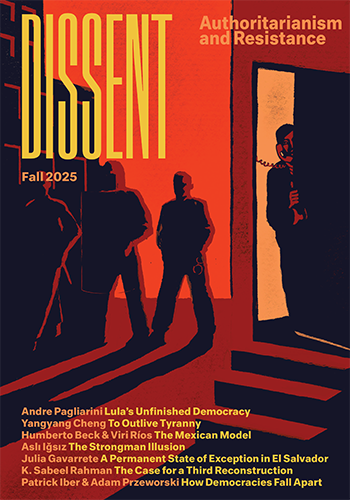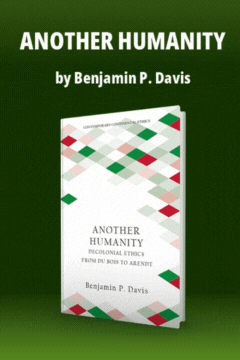American Ideologies
American Ideologies
To understand everything that happens in Latin America in relation to the United States is to brush aside inconvenient details in favor of a morality play.

America, América
by Greg Grandin
Penguin Press, 2025, 768 pp.
In a series of lectures on the philosophy of history delivered in the 1820s, around the time Spain’s colonies in the Western Hemisphere were declaring independence, Georg Wilhelm Friedrich Hegel declared that America was “the land of the future.” For those “weary of the historical lumber-room of old Europe,” the New World promised a chance “to abandon the ground on which hitherto World History has developed.” But this potential to break free from the past wasn’t evenly distributed across the Americas. In the part of the hemisphere that had been “colonized” by Protestants, where “all citizens” were of “European descent,” Hegel found “an increase of industry and population, civil order, and firm freedom.” By contrast, in the region that had been “conquered” by Catholics, where the friars had “proposed to accustom the Indians to European culture,” he saw nothing but “a continued revolution.”
The divergence of the two Americas struck the philosopher as a far more consequential distinction than a difference of culture; it was a contradiction between concepts. This position was consistent with Hegel’s metaphysical idealism, which saw the mind not as a subjective reflection of the material world but as objective reality itself, and which therefore conceived of history as a collective journey toward self-understanding. In this scheme, the growing tensions between the Protestant and Catholic regions of the New World were bound to explode not because the interests of their peoples were at odds, but because the two Americas embodied incompatible ways of being human. And if America was the future of humanity, the United States was the future of America.
The Pulitzer Prize-winning historian Greg Grandin’s monumental new work, America, América, is a dialectical reversal of Hegel’s ideas about the history of the New World. Taking as a point of departure the commonplace that the Spanish word americano can refer to a person from any part of the Americas, while the English term American refers only to people from the United States, the book is a history of the Western Hemisphere—“all of it: from the Spanish Conquest” to “the United Nations and beyond.”
Such a project would be an ambitious undertaking in a single volume, even one that stretches over 700 pages, but Grandin has something even bigger in mind. His book, he writes, is also “a history of the modern world, an inquiry into how centuries of American bloodshed and diplomacy” have given form to our own era’s moribund “liberal international order.” Still, even the most totalizing narrative must approach its object from a particular angle, so Grandin has chosen to focus on “the New World’s long history of ideological and ethical contestation.”
America, América, then, is not so much a history of ideas as it is an idealist history. When Grandin writes that both Simón Bolívar and Thomas Jefferson considered America “more an ideal than a place,” he might as well be describing Hegel—or himself. The crucial difference is that Grandin inverts the German philosopher’s moral hierarchy. In Grandin’s scheme, it is Latin America, not the United States, that holds the key to the future of humanity.
There is much to admire in America, América. Grandin is just as adept at guiding the reader through theological disputations in early modern Spain as he is at relating the tensions within Franklin D. Roosevelt’s State Department. The chapter dedicated to colonial New England has something of Susan Howe; the section about the 1948 murder of Colombian populist Jorge Eliécer Gaitán reminds me of Gabriel García Márquez’s literary journalism. Unlike many academics, Grandin can write a sentence and tell a story. I feel compelled to pay America, América the highest compliment I can offer: it is a work of literature.
More than anything else, Grandin should be commended for his vindication of what he calls “Latin America’s worldview.” In his scheme, the region’s “humanist” approach to politics—along with economics, literature, theology, diplomacy, ethnic inclusion, social welfare, and above all international law—constitutes a “remarkably coherent” rebuttal to the imperialist ideology of the United States. Now that the country that hubristically calls itself America has yet again been taken hostage by a clique of dime-store Eichmanns, it’s heartening to watch a U.S. historian conjure the spirit of Bartolomé de las Casas, the sixteenth-century Spanish friar who dedicated his life to defending the Indigenous peoples of the New World from the abuses of European colonizers.
Yet America, América is ultimately disappointing. Essentializing millions of people from dozens of cultures that seem similar only when considered from the perspective of the United States—even if it is to vindicate them—is another form of imperial condescension.
Though America, América features as large a cast of characters as one would expect from a work of history that aspires to synthesize the development of an entire hemisphere over the course of half a millennium, Las Casas is very much the book’s central figure. In an early chapter, one of the book’s best, Grandin gives the reader a guided tour of the priest’s life and miracles: his conversion from slaveholding settler to abolitionist agitator, his repurposing of Catholic canon law to argue for the sovereignty of Indigenous nations, and his rebuttal of neo-Aristotelian arguments for “natural slavery.”
Yet the friar has a long afterlife in America, América. Grandin returns to him throughout the book, to the point that “Las Casas” soon strikes the reader less as the name of an individual than as a leitmotif designed to bring to the fore the supposed coherence of Latin America’s humanist worldview. Like Hegel, Grandin explains the world by dividing it into binaries of theses and antitheses. The most important of these pairings is the contrast between Las Casas’s Catholic universalism and the Protestant particularism of the likes of Cotton Mather. Though Grandin certainly grants that material factors played an important role in shaping the political economies of the British and Spanish empires—he notes that by the time the first English settlers landed in Massachusetts, pathogens brought by the Spaniards had already killed some 90 percent of the Indigenous population—he also seems to think that theological beliefs can explain why the Spanish tried to assimilate the people they had conquered while the English decided to displace or exterminate them.
One need not appeal to the difference between consubstantiation and transubstantiation to account for these two versions of hell. The Indigenous societies that each group of settlers encountered were themselves quite different. Where the Spaniards met so-called complex societies, as they did in present-day Mexico and Peru, they found it expedient to graft their colonial regime onto the pre-existing structures of the Mexica and Inca states; where they found hunter-gatherers or “simple” sedentary groups, as they did in the Antilles, they behaved much like their Protestant rivals. Under this alternative explanation, Mather and Las Casas’s antithetical theologies appear not as etiologies of different illnesses but rather as symptoms of the same disease.
America, América makes a great deal of the fact that some of the former Spanish colonies abolished chattel slavery long before the United States, noting with approval that Mexico became a haven for enslaved Black people fleeing the American South. But many scholars now believe that the abolition of chattel slavery in former New Spain had very little to do with humanist ideas and everything to do with the fact that the country’s white elite discovered that it was simply more profitable to exploit Indigenous labor through debt-bondage—which, according to Las Casas, is simply another kind of slavery—such that, by the time the viceroyalty became the first Mexican Empire and then the Mexican Republic, there were very few enslaved people of African descent living in its territory. Had the criollos of early independent Mexico been sugarcane planters rather than silver-mining barons—and had they not needed to recruit people of all castes during the War of Independence—it’s likely that they would have persisted in enslaving Black people for much longer, as was the case in Brazil, Cuba, and the American South.
A teacher of mine used to say that one should always be suspicious when historians use the phrase “what we now would call” to qualify their use of a concept that didn’t exist in the period under consideration, because such sleights of hand insert a hidden teleology into history. In his chapter on Las Casas, Grandin performs this magic trick with “social justice” and “structural violence,” presumably to make the friar’s ideas easier to understand. The truth, however, is that Las Casas was neither a structuralist avant la lettre nor a proto-activist. To imply otherwise prevents us from grasping the radical foreignness of a thinker for whom the fight against oppression was not so much a matter of life and death as a question of heaven and hell.
There’s no question that Las Casas’s ideas are inspiring. But Grandin’s insistence on reading the friar as a precursor to Bolívar and company showcases the tendencies that make America, América a great polemic against U.S. reactionaries and a reactionary history of Latin America. When Bolívar or the liberation theologians cite Las Casas, they are not discovering a precedent but giving voice to the contradictions of their own ages.
These objections may seem minor, particularly given that the more sophisticated version of Grandin’s argument for Las Casas’s importance—that his writings were an important inspiration for modern international law—isn’t especially controversial. Authors as ideologically diverse as Enrique Dussel and Rolena Adorno have made similar claims, as did many of the Latin American jurists who developed much of that legal framework. Grandin dedicates a considerable portion of the book to these jurists, to the point that America, América at times seems to want to be a much more circumscribed inquiry: an exploration of the Latin American origins of a body of legislation that so far has failed to protect the wretched of the earth from the likes of Henry Kissinger.
But Grandin dramatically expands Las Casas’s sphere of influence. In America, América, the friar is not just the grandfather of international law, but also the source of a Latin American Spirit that flies over the muck and mire of the centuries, leaving trails in the pristine skies of the realm of ideas, connecting everyone from Bolívar to García Márquez. But what are we to make of the fact that the latter’s novel about the former, The General in His Labyrinth, is an ambivalent entry in the canon known as the “novel of the dictator”? What goes for García Márquez and Bolívar goes for countless others. Grandin writes in similar terms about Mexico’s Lázaro Cárdenas and Chile’s Salvador Allende, implicitly suggesting that both leaders belong to the same pantheon of Latin American humanists, even though the former was a general who consolidated an authoritarian party and the latter a democratically elected civilian who was ousted by an authoritarian general.
The problem is not just that Grandin thinks that Latin Americans are essentially the same, but that he seems convinced that they are essentially good. This idealization comes into view each time he avoids the painfully evident fact that the region has produced a veritable legion of anti-humanist thinkers and unethical leaders. Just as Las Casas was a product of the same culture as Hernán Cortés, Augusto Pinochet was every bit as Chilean as Allende. Yet over and over again, Grandin implies that Latin American reactionaries were not really Latin American, because they had fallen prey to the nefarious influence of the United States.
This position leads Grandin to present interpretations of crucial events that are too simplistic to be taken seriously. His narrative of the military coup that in 1913 triggered the most violent phase of the Mexican Revolution, for instance, attributes an outsize importance to the U.S. Ambassador Henry Lane Wilson. The American diplomat met and likely bribed General Victoriano Huerta shortly before the latter ordered the killing of President Francisco I. Madero, the democratically elected liberal aristocrat who, less than two years earlier, had ousted longtime liberal dictator Porfirio Díaz.
There’s no question that Wilson and his faction in William Howard Taft’s lame-duck government had no qualms about supporting putschists to protect the foreign interests of their country’s capitalist class. But Grandin’s suggestion that “the proximate events leading to the Mexican president’s demise” and hence to civil war were the result of American machinations risks reducing the Mexican Revolution into an anticolonial revolt against the United States. At times it certainly was that, but the decade of chaotic violence that began with Madero’s assassination was at heart the result of class struggles within Mexican society. The only way to present it as yet another episode in the epic struggle between America and América is to brush aside countless inconvenient details and replace the unnerving contradictions of history with the satisfying simplicity of a morality play.
Consider one such detail. The coup that killed Madero in fact began days before the meeting between Wilson and Huerta, when a different general, Bernardo Reyes, Diaz’s right-hand man and heir apparent, escaped from the prison where he was serving a sentence for sedition, ever since his first attempt to overthrow the legitimate government had fizzled out more than a year earlier. The elderly Reyes rallied the troops of a nearby garrison and marched to the National Palace with the intention of deposing Madero and assuming the presidency—only to die moments later in the central plaza of Mexico City, felled by one of the first shots of the revolution.
I bring up Reyes not to raise the pedantic question of whether the coup began on February 9 or February 13, but because the general’s contradictions are illustrative of larger problems in Grandin’s book. A veteran of the war against the puppet Habsburg monarchy that Napoleon III installed in Mexico in the 1860s, Reyes was one of those paradoxical Mexican reactionaries who hoped to impose order not to restore tradition but to usher in modernity. (I would have loved to watch Grandin grapple with this anti-humanist tradition, particularly with the work of José Vasconcelos, the fascist philosopher who in the 1920s laid the cultural groundwork for Cárdenas’s party—and whose Bolivarismo y monroísmo often sounds uncomfortably similar to America, América.)
Like many Mexican reactionaries before and after him, Reyes was an anti-imperialist nationalist who saw the United States as Mexico’s historic enemy. His son, the brilliant essayist Alfonso Reyes, recounts in his memoirs that the only time any of the general’s children saw him cry was when his sister caught him weeping over “certain passages about the Mexican–American War.” The United States, it appears, did not feel warmly about Reyes either: his first attempted coup in late 1911 failed because the American authorities, at the request of Madero’s ambassador, detained the general and his supporters, who had crossed the border to secure weapons and rally their men after Reyes publicly called for rebellion.
Reyes’s anticlimactic death in the first minutes of a civil war that claimed close to a million lives has made him a far more obscure figure than Huerta. But the fact that it was him, and not Huerta, who was supposed to take over as president after Madero had been forced out of the National Palace suggests that the coup that put an end to Madero’s life was an eminently domestic affair: the panicked reaction of a national bourgeoisie that feared for its economic interests after losing control of the state apparatus.
Moreover, if the “proximate” cause for the Mexican Revolution was a precursor to more recent U.S. attempts to overthrow legitimate Latin American governments, as Grandin’s focus on Wilson’s meeting with Huerta suggests, why didn’t Taft’s State Department ignore Madero’s request, or even furnish Reyes with funds and matériel? It’s frustrating to see a committed anti-imperialist like Grandin fall prey to the old temptation of understanding everything that happens in the world in relation to the United States.
Reyes is not the only figure whose inclusion in America, América would have complicated Grandin’s argument. An Andean critic might invoke Peruvian Marxist José Carlos Mariátegui, who thought about the ideological divergence of the United States and Latin America in terms of the difference between the political economies of the British and Spanish empires. A Brazilian reader could reasonably wonder why this history of the New World has more to say about the racial terror that broke loose in Venezuela over the course of a few years during Bolívar’s campaign against Spanish rule than it does about five centuries’ worth of ethnic strife in the most populous nation in Latin America. The fact that countless such objections can be raised means either that this line of criticism is meaningless or that the very premise of a history of “all of it” is catastrophically flawed.
I’m inclined for the first option: I wish more academics were willing to risk objections such as the ones I’ve raised. But there are other absences in America, América that present far more serious problems. Reyes was able to ascend to the highest echelons of the dictatorial regime in great part because of his military distinction in the so-called pacification of northern Mexico—which is a euphemistic way of saying that he proved remarkably efficient in the displacement, dispossession, and mass killing of the Yaqui, Rarámuri, and other Indigenous nations. On this point, more than on any other, Reyes was a true son of Latin America: the independent governments of Chile, Argentina, Brazil, and practically every other nation in the region inflicted and continue to inflict similar violence against a constellation of unrelated peoples to whom Grandin refers to as “Native Americans” or “Indians.”
Many of the conflicts that ensued from this most Latin American tradition of internal colonialism have been described as genocidal; in some cases, contemporary leftist governments that Grandin regards with sympathy have felt the need to offer formal apologies to the survivors of the campaigns that their predecessors waged against their peoples long after independence. But a reader who knew nothing about the region save what they learned in America, América would walk away from the book under the impression that Latin America’s humanism “removed the imperative for genocide: the lines were fixed, and Indigenous peoples—be they Mexico’s Maya, Chile’s Mapuche, or Gran Colombia’s Wayuu—could stay put.”
I read this and other similar lines with incredulity. Does Grandin not know about the so-called Caste Wars, as the Mexican state’s fifty-year exterminationist offensive against a nineteenth-century Maya rebellion is known? Or about the ethnic cleansing that took place around the same time in the territory that is now known as the Araucanía Region of Chile, a territory that according to Las Casas should belong exclusively to the Mapuche? Or, for that matter, about the displacement in our own time of the Wayuu, who have been abandoned to the depredations of drug cartels by the nation-states that claim their land as their own?
Grandin’s refusal to confront the fact that Latin America is full of genocidal anti-humanists leads him to forget that there are countless people in Latin America whose cultures predates the concept of America, whose languages are in no way Latinate, and who to this day continue to resist the abuses of Bolívar’s “humanist” inheritors. Indigenous historical actors play minor roles at best in America, América. Not even towering figures such as Benito Juárez or Evo Morales merit so much as a passing mention. The result is that in this book, as in Hegel’s lectures, “what takes place in America is but an emanation from Europe.”
In the introduction to his recent social history of the Mexican–American War, The Dead March, Peter Guardino writes that “our ideas about the societies we live in are shaped by implicit comparisons.” The problem, he goes on, is that “implicit comparisons are typically sloppy.” The task of the historian, then, is to make comparisons not only “more explicit but also more precise.” Here, I think, is the root of my problem with Grandin’s book: his argument hinges on a binary comparison at such a large scale that it forgoes any specificity. If it proves difficult to say something at once coherent and true about a group of people as diverse as Mexicans, it’s downright impossible to say anything meaningful about Latin America as a whole.
If one forgets that García Márquez’s Colombia is rather unlike Bolívar’s Gran Colombia, the working-class newsman from twentieth-century Bogotá and the aristocratic warlord from nineteenth-century Caracas could be said to be something close to countrymen. But I’m not sure that this observation is any more revealing than pointing out that Abraham Lincoln and Gore Vidal were both born in the United States. Would we be comfortable saying that they shared a worldview? What about Bernie Sanders and Donald Trump, two outer-borough white New Yorkers from the same generation? Don’t the nearly 665 million people who live in the mosaic of fractious nation-states that we call Latin America have the same capacity for political disagreement and moral dissimilarity? There’s a reason why grand narratives that figure history as a series of clashes between antithetical cultures or civilizations—two words that, in this context, are almost always euphemisms for “races”—have long fallen out of fashion: their explanatory power hinges on stereotypical generalizations. This danger is especially acute when we seek to make sense of these clashes between cultures in moral terms.
The decisive blow to Hegel’s philosophy of history, of course, was struck by none other than Karl Marx, who came to think that history was not a matter of a battle of beliefs or ideas, much less a contest between good or evil, but of how societies produce what people need to stay alive. To think otherwise was to fall prey to the same mystification that had led Hegel’s radical young followers to the conclusion that solving philosophical problems would bring justice to the world. Marx began his systematic critique of Hegel’s idealism in a book that he co-authored with Friedrich Engels, The German Ideology. Their project was to turn Hegel on his head by showing that the Spirit was a byproduct of the economy, and not the other way around. Grandin appears to have had something similar in mind in America, América. It’s unfortunate that he instead fell prey to the temptations of the American ideology.
Nicolás Medina Mora is a Mexican writer. His first novel, América del Norte, was published last year by Soho Press.






